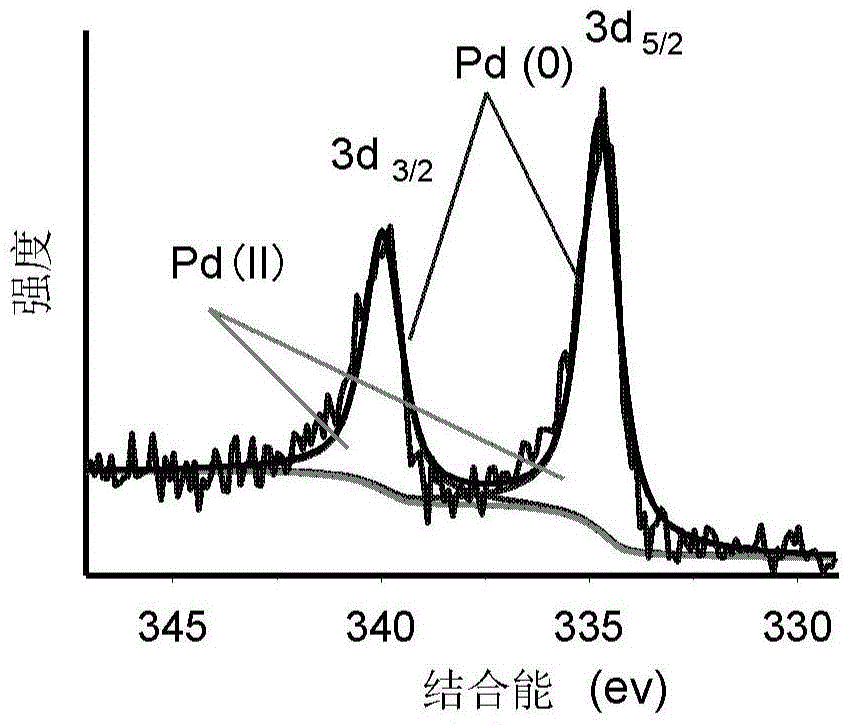Method for in-situ synthesis of three-dimensional nanometer palladium catalyst layer through electrode activity biological membrane and application
An in-situ synthesis, three-dimensional nanotechnology, applied in the field of electrochemistry and bio-nanomaterials, can solve problems such as hindering electron transfer, distribution of dead angles, and increasing costs, and achieve the effects of reducing cost input, high electrocatalytic activity, and improving catalytic activity
- Summary
- Abstract
- Description
- Claims
- Application Information
AI Technical Summary
Problems solved by technology
Method used
Image
Examples
Embodiment 1
[0040] Inoculate the electrochemically active bacteria Geobacter Sulfurreducens PCA (DSM12127; ATCC51573) into the anaerobic sealed electrolytic cell buffer at a ratio of 30%, and add 1.5g of NH per liter of buffer 4 Cl, 0.6g of NaH 2 PO 4 , 0.1g of KCl, 2.5g of NaHCO 3 , 0.82g of CH 3 COONa, 10ml of Wolfe's trace element solution (add 1.5g of NH per liter of buffer 4 Cl, 0.6g of NaH 2 PO 4 , 0.1g of KCl, 2.5g of NaHCO 3 , 0.82g of CH 3 COONa, 10ml Wolfe's trace element solution (each liter contains 2.0mg biotin, 2.0mg folic acid, 10.0mg pyridoxine hydrochloride, 5.0mg thiamine, 5.0mg riboflavin, 5.0mg niacin, 5.0mg calcium pantothenate, 0.1mg vitamin B12, 5.0mg p-aminobenzoic acid, 5.0mg lipoic acid, 1L deionized water)) and 10ml of Wolfe's vitamin solution (10.0mgNa 2 SeO 3 , 10.0mgNiCl 2 ·6H 2 O, 10.0mgNa 2 WO 4 2H 2 O, 1.5g nitrilotriacetic acid, 3.0g MgSO 4 ·7H 2 O, 0.5gMnSO 4 ·H 2 O, 1.0gNaCl, 0.1gFeSO 4 ·7H 2 O, 0.1g CoCl 2 ·6H 2 O, 0.1g CaCl 2 , ...
Embodiment 2
[0043] Same as Example 1, the only difference is that the electrochemically active bacterium Geobacter Sulfurreducens PCA (DSM12127; ATCC51573) was inoculated into the buffer solution of the anaerobic sealed electrolytic cell at a ratio of 40%.
Embodiment 3
[0045] With embodiment 1, the only difference is that the working electrode has an effective area of 1 cm -2 conductive glass.
PUM
 Login to View More
Login to View More Abstract
Description
Claims
Application Information
 Login to View More
Login to View More - R&D
- Intellectual Property
- Life Sciences
- Materials
- Tech Scout
- Unparalleled Data Quality
- Higher Quality Content
- 60% Fewer Hallucinations
Browse by: Latest US Patents, China's latest patents, Technical Efficacy Thesaurus, Application Domain, Technology Topic, Popular Technical Reports.
© 2025 PatSnap. All rights reserved.Legal|Privacy policy|Modern Slavery Act Transparency Statement|Sitemap|About US| Contact US: help@patsnap.com



